AUDI S8 2011 Owners Manual
Manufacturer: AUDI, Model Year: 2011, Model line: S8, Model: AUDI S8 2011Pages: 302, PDF Size: 76.07 MB
Page 191 of 302
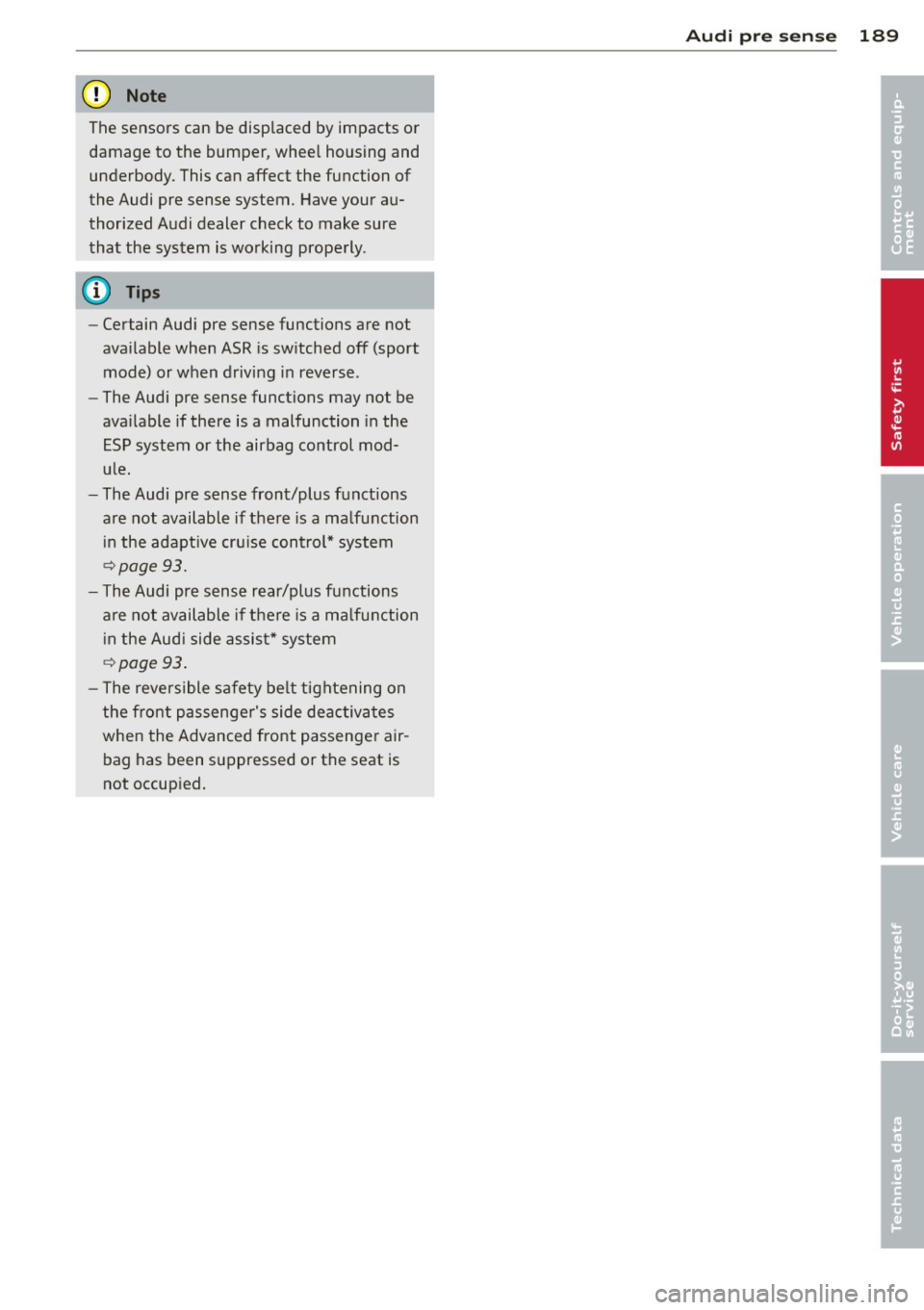
(D Note
The sensors can be displaced by impacts or damage to the bumper, whee l housing and
underbody. This can affect the function of
the Audi pre sense system. Have your au
thor ized Audi dealer check to make sure
that the system is working properly .
(D Tips
-Certain Audi pre sense functions are not
available when ASR is sw itched off (sport
mode) or when driving in reverse .
- The Audi pre sense functions may not be
ava ilable if there is a malfunction in the
ESP system or the airbag control mod
u le.
- The Audi pre sense front/plus functions
are not available if there is a ma lfunction
i n the adapt ive cru ise control* system
¢ page 93.
-The Audi pre sense rear/plus functions
are no t available if there is a ma lfunction
i n the Audi side assis t* system
¢ page 93 .
-The reversible safety be lt t ightening on
the front passenger's side deactivates
when the Advanced front passenge r air
bag has been s uppressed or the seat is
not occup ied.
Audi pr e sense 189
•
•
Page 192 of 302
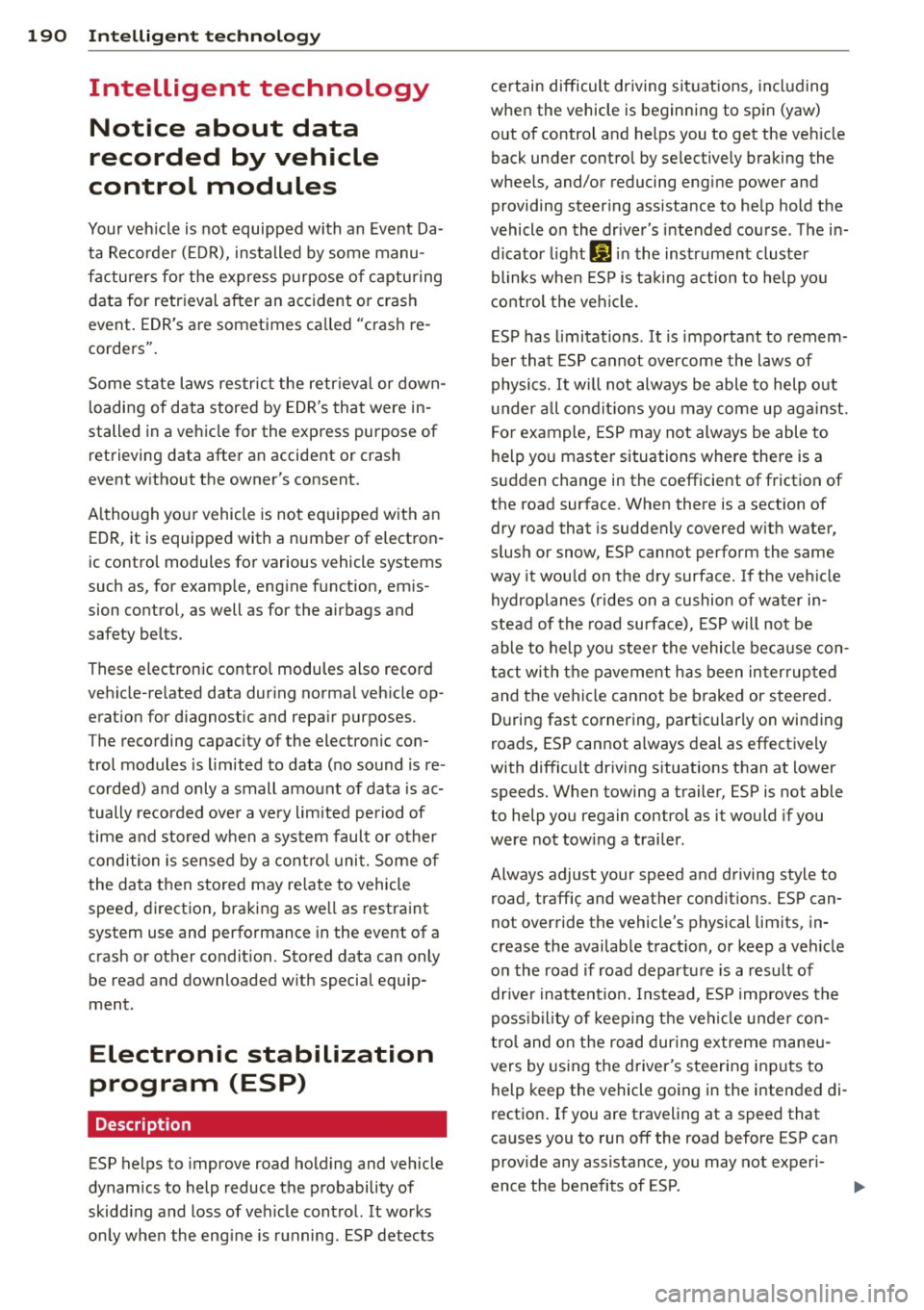
190 Intelligent technology
Intelligent technology Notice about data
recorded by vehicle
control modules
Your veh icle is not equipped with an Event Da
ta Recorder (EDR), installed by some manu
facture rs for the express purpose of capturing
data for retrieval after an accident or crash
event . EDR's are sometimes ca lled "crash re
corders".
Some state laws restrict the retr ieval or down
loading of data stored by EDR's that were in
stalled in a vehicle for the express purpose of
retrieving data after an accident or crash
event without the owner's consent.
A lthough your vehicle is not equipped with an
EDR, it is equipped with a number of electron
ic control modules for various vehicle systems
such as, for example, eng ine function, em is
sion control, as well as for the airbags and
safety belts.
These electronic contro l modules also record
vehicle-re lated data during normal vehicle op
eration for diagnostic and repair purposes.
The recording capacity of the electronic con
trol modules is limited to data (no sound is re
corded) and only a small amount of data is ac
tually recorded over a ve ry limited pe riod of
time and stored when a system fault or other
cond ition is sensed by a control unit. Some of
the data then stored may re late to vehicle
speed, direction, braking as we ll as restraint
system use and performance in the event of a
crash or other condition. Stored data can only
be read and downloaded with special equip
ment.
Electronic stabilization
program (ESP)
Description
ESP helps to improve road holding and vehicle
dynamics to help reduce the probability of
skidd ing and loss of veh icle control. It works
only when the engine is running. ESP detects certain difficult driving situat
ions, including
when the vehicle is beginning to spin (yaw) out of control and helps you to get the veh icle
back under control by se lectively braking the
wheels, and/or reducing engine power and
providing steer ing assistance to help hold the
vehicle on the driver's intended course. The in
dicator light
liJ in the instrument cluster
blinks when ESP is taking action to help you
control the vehicle.
ESP has limitations.
It is important to remem
ber that ESP cannot overcome the laws of
physics. It will not always be able to help out
under all conditions you may come up against.
For example, ESP may not always be able to
help you master situations where there is a
sudden change in the coefficient of friction of
the road surface. When there is a section of dry road that is suddenly covered w ith water,
slush or snow, ESP cannot perform the same
way it wou ld on the dry surface . If the vehicle
hydroplanes (rides on a cushion of water in
stead of the road surface), ESP will not be
able to help you steer the vehicle because con
tact with the pavement has been interrupted
and the vehicle cannot be braked or steered.
During fast cornering, particularly on winding
roads, ESP cannot always deal as effectively
with difficult driving situations than at lower
speeds. When towing a trailer, ESP is not able
to help you regain control as it would if you
were not tow ing a trailer.
Always adjust your speed and driving style to road, traffic; and weather condit ions. ESP can
not override the vehicle's physical limits, in
crease the available traction, or keep a ve hicle
on the road if road departure is a result of
driver inattention. Instead, ESP improves the
poss ibility of keeping the vehicle unde r con
trol and on the road during extreme maneu
vers by using the driver's steering inputs to
help keep the vehicle going in the intended di
rection . If you are traveling at a speed that
causes you to run off the road before ESP can
provide any assistance, you may not experi
ence the benefits of ESP .
Page 193 of 302
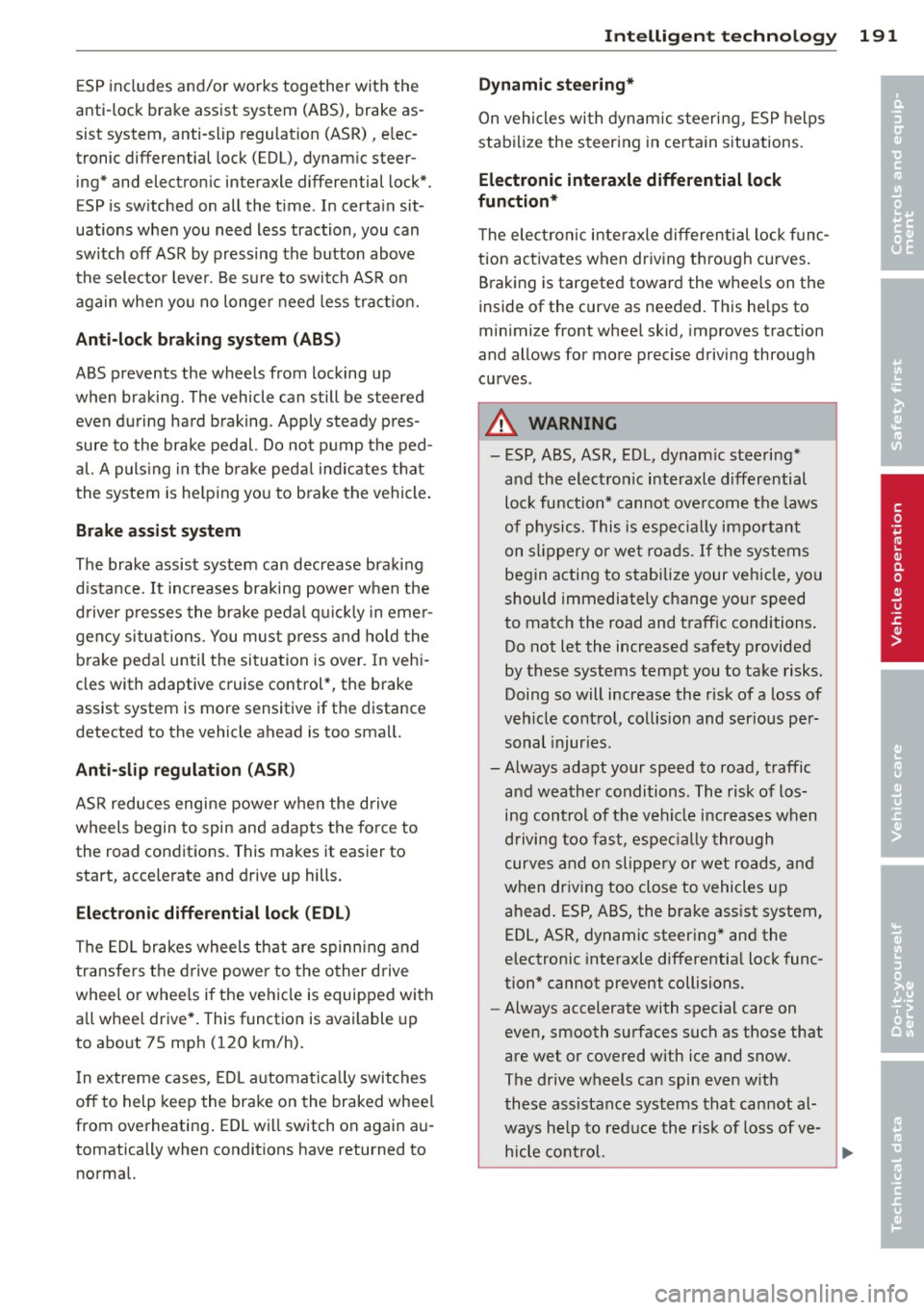
ESP includes and/or works together with the
anti-lock brake assist system (ABS), brake as
sist system, anti -slip regulation (ASR), elec
tronic differential lock (EDL), dynamic steer
ing* and electronic interaxle differential lock*.
ESP is switched on all the t ime . In certa in sit
uations when you need less traction, you can
sw itch
off ASR by pressing the button above
the selector lever. Be sure to switch ASR on
again when you no longer need less traction.
Anti-lock braking system (ABS)
ABS prevents the wheels from locking up
when braking. The vehicle can still be steered even during hard braking . Apply steady pres
sure to the brake pedal. Do not pump the ped
al. A puls ing in the brake pedal indicates that
the system is he lping you to brake the vehicle.
Brake assist system
The brake assist system can decrease brak ing
distance.
It increases braking power when the
driver presses the brake pedal quickly in emer
gency situations. You must press and hold the
brake pedal until the situation is over. In vehi
cles with adaptive cruise control*, the brake
assist system is more sensitive if the distance
detected to the vehicle ahead is too small.
Anti-slip regulation (ASR)
ASR reduces engine power when the drive
wheels begin to spin and adapts the force to
the road conditions. This makes it easier to
start, accelerate and drive up hills .
Electronic differential lock (EDL)
The EDL brakes wheels that are spinning and
transfers the drive power to the other drive
wheel or whee ls if the vehicle is equipped with
a ll whee l drive *. This function is available up
to about 75 mph (120 km/h).
I n extreme cases, EDL automatically switches
off to help keep the brake on the braked wheel
from overheating . EDL will switch on again au
tomatically when conditions have returned to
normal.
Intelligent technology 191
Dynamic steering*
On vehicles with dynamic steering, ESP helps
stabilize the steering in certain situations.
Electronic interaxle differential lock
function*
T he electronic interaxle differential lock func
tion activates when driving th ro ug h curves.
Braking is targeted toward the wheels on the
inside of the curve as needed. This he lps to
minimize front whee l skid, improves traction
and allows for more precise driving through
curves .
A WARNING
- ESP, ABS, ASR, EDL, dynamic steering*
a nd the electronic interaxle differential
loc k fu nction* cannot overcome the laws
of physics. This is especially impo rtant
on slippery or wet roads.
If the systems
begin acting to stabilize your vehicle, you
should immediately change yo ur speed
to match the road and traffic conditions .
Do not let the increased safety provided
by these systems tempt you to take risks.
Doing so will increase the risk of a loss of
veh icle contro l, collision and ser ious per
sonal injur ies.
- Always adapt your speed to road, traffic
and weather conditions. The risk of los
ing con trol of the vehicle increases when
driving too fast, espe cially through
curves and on slippery or wet roads, and
when dr iving too close to vehicles up
ahead. ESP, ABS, the brake assist system,
EDL, ASR, dynam ic steer ing* and the
electronic interaxle differentia l lock func
tion* cannot prevent collisions.
- Always accelerate with special care on
even, smooth surfaces such as those that
are wet or covered with ice and snow.
The drive wheels can spin even with
these assistance systems that cannot al
ways he lp to reduce the risk of loss of ve
hicle contro l.
-
•
•
Page 194 of 302
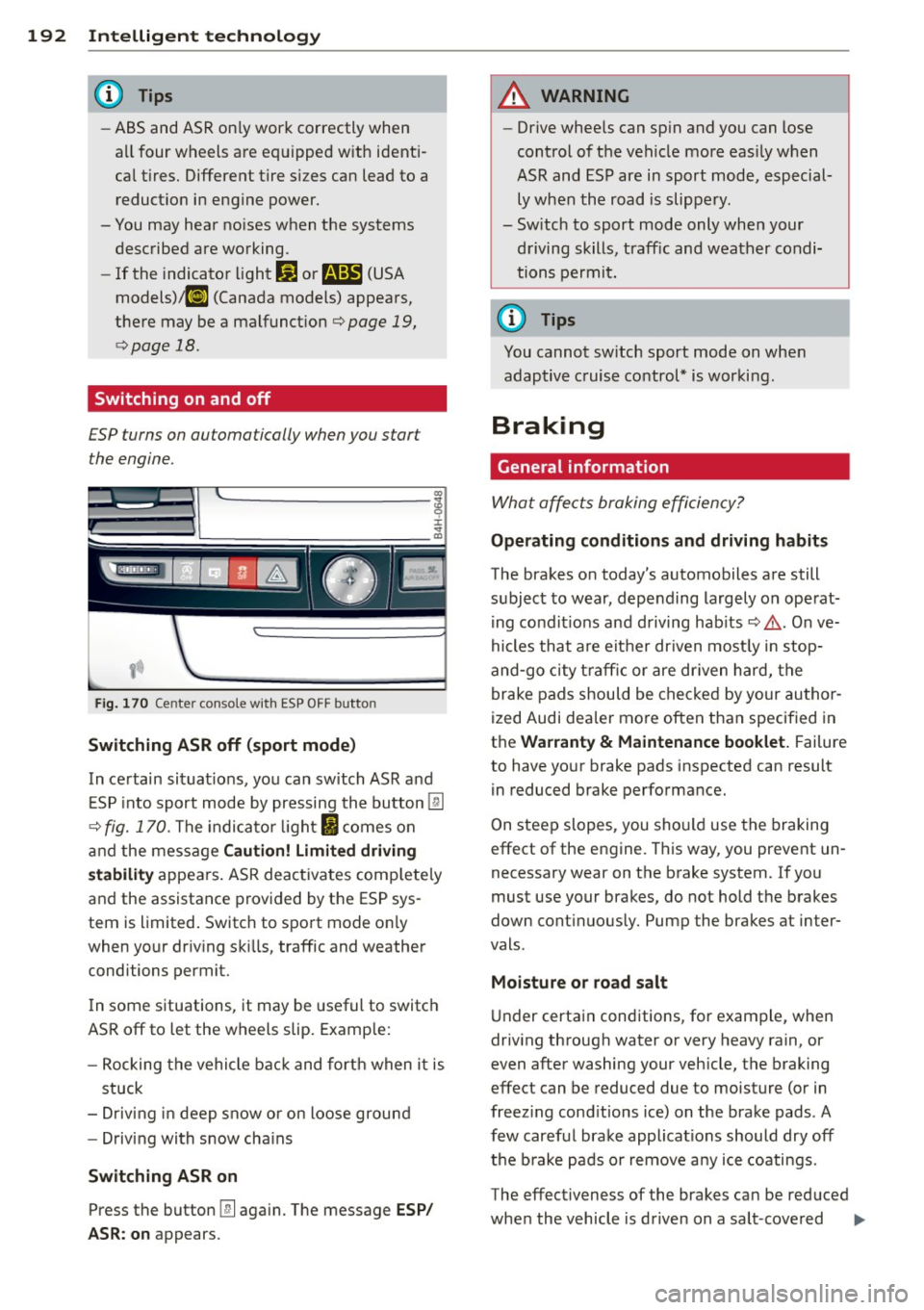
192 Intelligent technology
-ABS and ASR on ly work correctly when
a ll four wh eels are eq uipped w ith ident i
ca l tires. Different tire s iz es can lead to a
reduct ion in engine power.
- You may hear no ises when the systems
described are working.
- If the indicator light
DJ or m (USA
models) ;tl] (Canada models) appea rs,
there may be a malfunct ion
c::;, page 19,
c::;, page
18 .
Switching on and off
ESP turns on au toma tically when you s tar t
the engine .
Fig . 170 Cen ter con sole w it h ESP OF F button
Switching ASR off (sport mode)
In ce rtain situat io ns, yo u can switch ASR and
E SP into sport mode by pressing the button
l!I
c::;, fig. 170. The indicato r light fl comes on
and the mess age
C aution! Limit ed driving
s tability
appears . ASR deact ivates comp lete ly
and the assistance prov ided by the ESP sys
tem is limited. Switch to sport mod e onl y
when your d riv ing sk ills, traffic and weather
conditions permit.
In some situations, it may be useful to switc h
ASR off to let the wh eels slip. Example:
- Rocking the vehicle bac k and forth when it is
stuck
- Driv ing in deep snow or on loose ground
- Driving with snow cha ins
Sw itching ASR on
Press the button I!] aga in. The message ESP /
ASR: on appears .
A WARNING
-Drive whee ls can sp in and you can lose
control of the vehicle more eas ily when
ASR and ESP are in sport mode, especial
ly whe n the road is slippery .
- Sw itch to sport mode only when your
d riving skills, traff ic and weather condi
tions perm it.
@ Tips
You cannot sw itch sport mode on whe n
adaptive c ruise co ntrol* is worki ng.
Braking
General information
Wha t affe cts braking effi cien cy?
-
Operating conditions and driving habits
The brakes o n today's automobiles are still
s u bjec t to wear, depending largely on operat
ing cond it ions and driving hab its
c::;, &. . On ve
hicles that a re e it h er dr iven most ly in stop
and-go city t ra ffi c or are dr iven hard, the
brake pads should be checked by yo ur au thor
ized Audi dea ler mo re often than specified in
t h e
Warranty & Maintenance booklet. Failure
to have your brake pads inspected can result in reduced brake performance.
On steep slopes , you sho uld use the braking
effect of the engine. This way, you prevent un
necessary wear on the brake system . If you
must use your b rakes, do not hold t he brakes
down continuous ly. Pump the brakes at in ter
vals .
Moisture or road salt
U nd er certain conditions, for example, when
driving through water or very heavy rain, or
even after washing your veh icle, the braking
effect can be reduced due to moisture (or in
freez ing cond itions ice) on the brake pads . A
few caref ul brake applicat ions should dry off
t h e b rake pads or remove a ny ice coatings .
The effectiveness of the brakes ca n be reduced
when the vehicle is d riven on a sa lt-covered
ll>
Page 195 of 302

road and the brakes are not used. Here too,
you shou ld clean off accumu lated salt coating
from brake discs and pads with a few carefu l
applications of the brake
c> ,&. .
Cor rosion
There may be a tendency for dirt to build up
on the brake pads and corrosion to form on
the discs if the car is not driven regularly or
only for short trips with little use of the brakes.
If the brakes are not used frequently, or if cor rosion has formed on the discs, it is advisable
to clean off the pads and discs by brak ing
f irmly a few times from a moderately high
speed
c> &, .
Fau lts in th e bra ke s ystem
If you should notice a sudden increase in
brake peda l travel, then one of the two brake
ci rcu its may have failed
c> ,&. .
Low brak e fluid l evel
Malfunct ions can occur in the brake system if
the brake fluid level is too low. The brake fluid
leve l is monitored electronically.
Brake lining w ear statu s
Brake lining wear may be checked by visual in
spection of the condition of the brake pads
through the openings in the whee l. If neces
sary, the wheel may be removed for this in
spection
c> page 262, Changing a wheel .
8_ WARNING
-You should perform braking maneuvers
for the purpose of clean ing the brake
system on ly if road condit ions permit.
Other road users must not be put at r isk -
you may cause an acc ident!
- Before descending a steep grade, reduce
speed and shift transmiss ion into a lower
gear or lower driving range . Do not ride
the brakes or hold the pedal down too lo ng or too often. This cou ld cause the
brakes to get hot and dimin ish b raking
effi ciency.
Int ellig ent technolog y 193
-Do not "ride the brakes" by resting your
foot on the pedal when you do not intend
to brake. This may cause the brakes to
overheat, premature wear and increased
stopping distance .
- Under certain cl imatic and operat ing
conditions such as passing through wa
ter, dr iv ing in heavy rain or after washing
the vehicle, the effectiveness of the
b rakes can be reduced. In winte r, ice can
accumulate on the brake pads , lin ings,
discs and drums . Carefu lly app ly brakes
for a test . Brakes will dry and ice coat
ings wi ll be cleaned off after a few care
fu l brake applications.
- Driving for an extended period of time on
salt-covered roads without using your
brakes can a lso affect braking efficiency.
Clean off accumu lated salt coating from
brake discs and pads with a few careful
brake applications .
- If you damage the front spoiler, or if you
install a different spoiler, be sure the air
f low to the front brakes is not obstruct
ed. Otherw ise the brake system could
overheat reduc ing the effectiveness of
the entire brake system.
- Failure of one b rake circuit will impai r
the braking capab ility result ing in an in
creased stopping distance. Avoid driving
the vehicle and have it towed to the near
est A udi dealer or qualified workshop .
Brake booster
The brake booster adds extra braking power.
The brake booster works with vacuum pres
su re which is created only whe n the engine is
runn ing
c> &, .
A WARNING
-Never let the vehicle roll to a stop with
the engine shut off.
-
- If the b rake booster is no t working, for
examp le when towing you r vehicle, or
because the brake booster has somehow
Ill>
•
•
Page 196 of 302
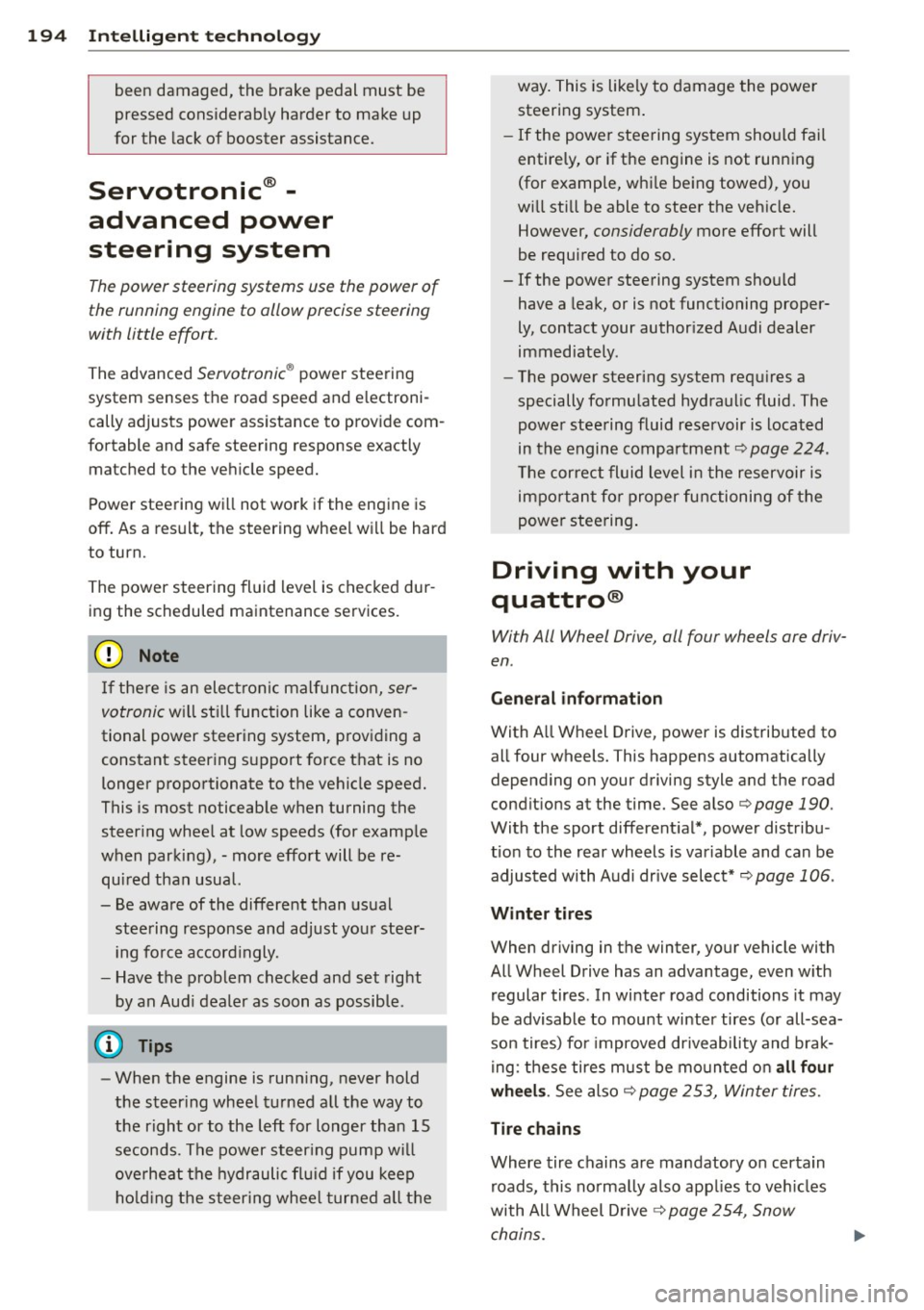
194 Intelligent technology
been damaged, the brake pedal must be
pressed considerably harder to make up
for the lack of booster assistance.
Servotronic ® -
advanced power
steering system
The power steering systems use the power of
the running engine to allow precise steering
with little effort .
The advanced Servotronic® power steering
system senses the road speed and e lectroni
cally adjusts power assistance to prov ide com
fortable and safe steering response exactly
matched to the veh icle speed.
Power steering w ill not work if the eng ine is
off . As a result, the steering whee l wi ll be hard
to turn.
The power steering fluid level is checked dur
ing the scheduled maintenance serv ices.
([) Note
If there is an electronic malfun ct ion, ser
votronic
w ill still f unction like a conven
tional power steer ing system, providing a
constant steering support force that is no
longer proportionate to the vehicle speed.
This is most noticeab le when turning the
steer ing whee l at low speeds (for examp le
when parking), - more effo rt will be re
qui red than usua l.
- Be aware of the different than usual
stee ring response and adjust yo ur stee r
i ng fo rce accord ingly.
- Have the p roblem checked and set rig ht
by an Aud i deale r as soon as possib le.
(D Tips
- When the engine is runn ing, never hold
t h e steer ing whee l turned all the way to
the right or to the left for longer than 15
se conds. The power steer ing p ump w ill
ove rhe at the hydr aulic flu id if you keep
ho ld ing the steering whee l turned all the way
. This is likely to damage the power
steering system .
- If the powe r steering system sho uld fai l
entirely, o r if the engine is not runn ing
(for examp le, whi le being towed), you
w ill sti ll be able to steer the veh icle.
However,
considerably more effort will
be required to do so.
- If the power steering system sho uld
have a leak, or is not functioning proper
ly, contact your author ized Audi dealer
immed iately.
- The power steering system requ ires a
specially fo rmu lated hydraulic fluid. The
powe r stee ring fluid reservoir is locat ed
in the engine compartment
Q page 224.
T he corre ct fl uid level i n the reservoir is
impo rta nt fo r proper fu nctioning of the
powe r stee ring .
Driving with your
quattro ®
With All Wheel Drive, all four wheels are driv
en .
Gen eral information
With A ll W heel Drive, power is distributed to
all four wheels. This happens automatically
depending on your driving style and the road
condit ions at the time. See also
Q page 190.
With the sport different ial*, powe r distribu
tion to the rear wheels is variable and can be
adjusted with Audi drive select*
Q page 106 .
Winter tires
When driving in the winter, yo ur vehicle with
All Wheel D rive has an advantage, even w ith
r egular tires . In wi nter road conditions it may
be advisable to mount winter tires (or all-sea
son tires) for improved driveability and brak
i ng : these tires must be mo unted o n
all four
wheel s. See also q page 253, Winter tires.
Tire chains
Where tire chains are mandatory on certa in
roads, this no rma lly also app lies to veh icles
with All Wheel D rive
q page 254, Snow
chains .
Page 197 of 302
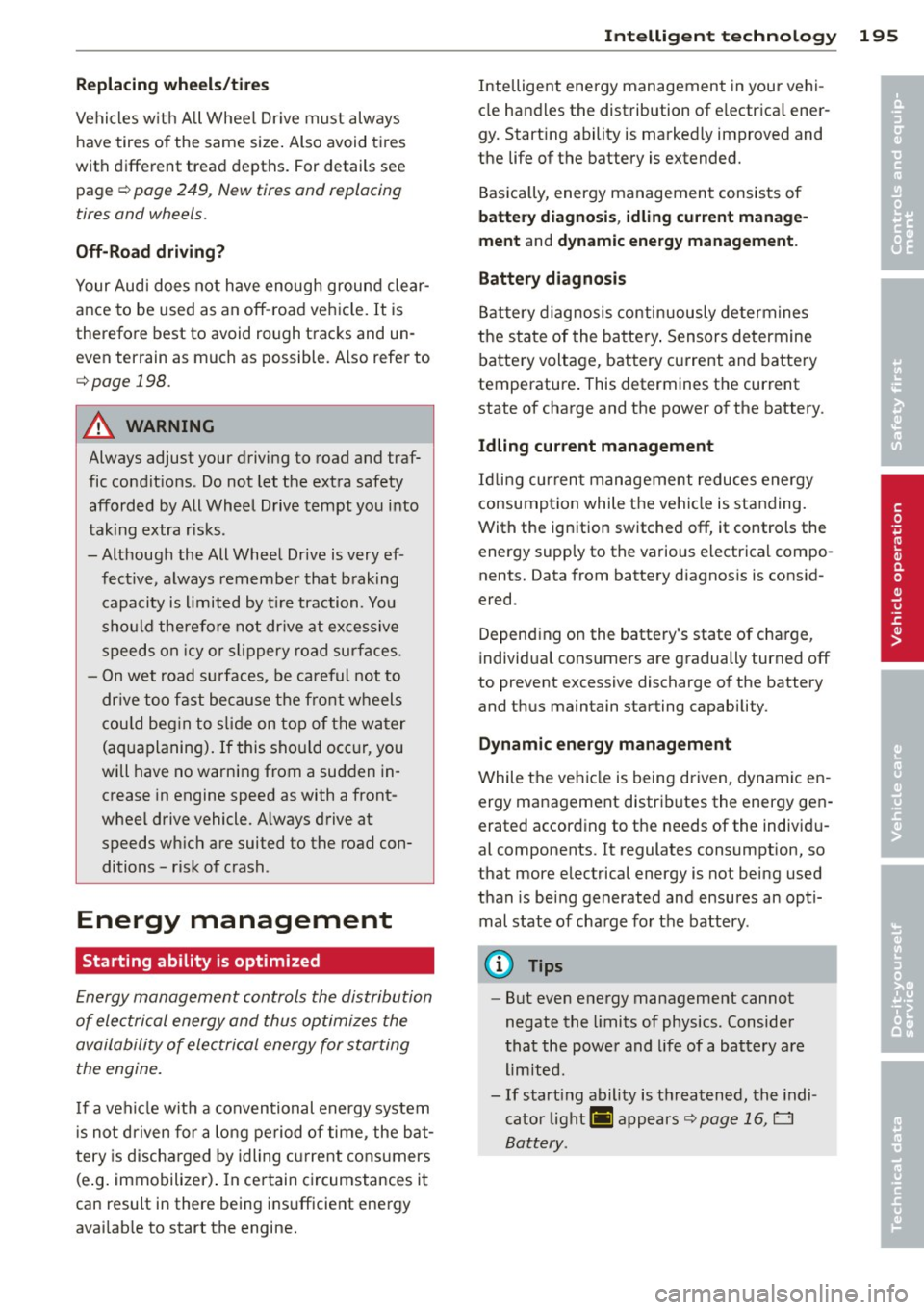
Replacing wh eels/ tire s
Vehicles w ith All Wheel Dr ive must always
have tir es of the same size. Also avoid tires
with different tread depths. For details see
pag e¢
page 249 , N ew tires and replacing
tires and wheels .
Off-Road driving?
Your Aud i does not have enough ground clear
ance to be used as an off -road vehicle. It is
therefor e best to avoid rough tracks and un
even terrain as much as possible . Also refer to
¢ page 198.
A WARNING
Always adjust your driving to road and traf
fic condit ions . Do not let the extra safety
afforded by All Wheel Drive tempt you into
taking extra risks.
- Although the All Wheel Drive is very ef
fective, always remember that braking
capacity is limited by t ire traction . Yo u
should the refore not dr ive at excessive
speeds on icy or s lippery road surfaces.
- On wet road su rfaces, be ca reful not to
dr ive too fast because the front wheels
cou ld beg in to s lide on top of the wa ter
(aquaplaning). If this sho uld occ ur, you
will have no warning from a sudden in
crease in engine speed as with a front
wheel drive vehicle. A lways drive at
speeds wh ich are suited to the road con
ditions -risk of crash .
Energy management
Starting ability is optimized
Energy management controls the distribution
of electrical energy and thus optimi zes the
availability of electrical energy for starting the engine.
If a vehicle wit h a conventional energy system
i s not driven for a long period of time , the bat
tery is discharged by idling cu rrent consumers
(e .g. immobilizer) . In certain circumstances it
can result in there being ins ufficient energy
avai lab le to start the engine.
Int ellig ent technolog y 195
Intelligent energy management in your vehi
cle hand les the distribution of e lectrica l ener
gy. Start ing ability is marked ly improved and
the life of the b attery is extended.
Bas ica lly, energy management consis ts of
batte ry diagnosi s, idling cur rent m anage
ment
and dynamic energ y management.
Battery diagnosis
Battery diagnosis continuously de termines
the state of the battery . Sensors de termine
batte ry voltage, battery current and battery
temperature . This determines the current
state of charge and the power of the batte ry .
Idling current management
Id lin g cur ren t management reduces energy
consumption while the vehicle is standing.
With the ig nition switched off, it controls the
energy supply to the various electrical compo nents. Data from battery diagnos is is cons id
ered.
Depend ing on the battery's state of cha rge ,
individua l cons umers are gradually turned off
to prevent excessive discharge of the batte ry
and th us maintain starting capability .
Dynamic energy manag ement
While the ve hicle is being driven, dynamic en
ergy management distrib utes the energy ge n
erated according to the needs of the individ u
al components . It regulates consumption, so
that more electrical energy is not being used
than is being generated and ensures an opti
mal state of charge for the battery .
@ Tips
-But even energy management cannot
negate the limits of physics. Consider
t hat the powe r and l ife of a battery are
limited.
- If start ing ability is threatened, the indi
cator light
(•i appears ¢ page 16, c:::3
Battery.
•
•
Page 198 of 302
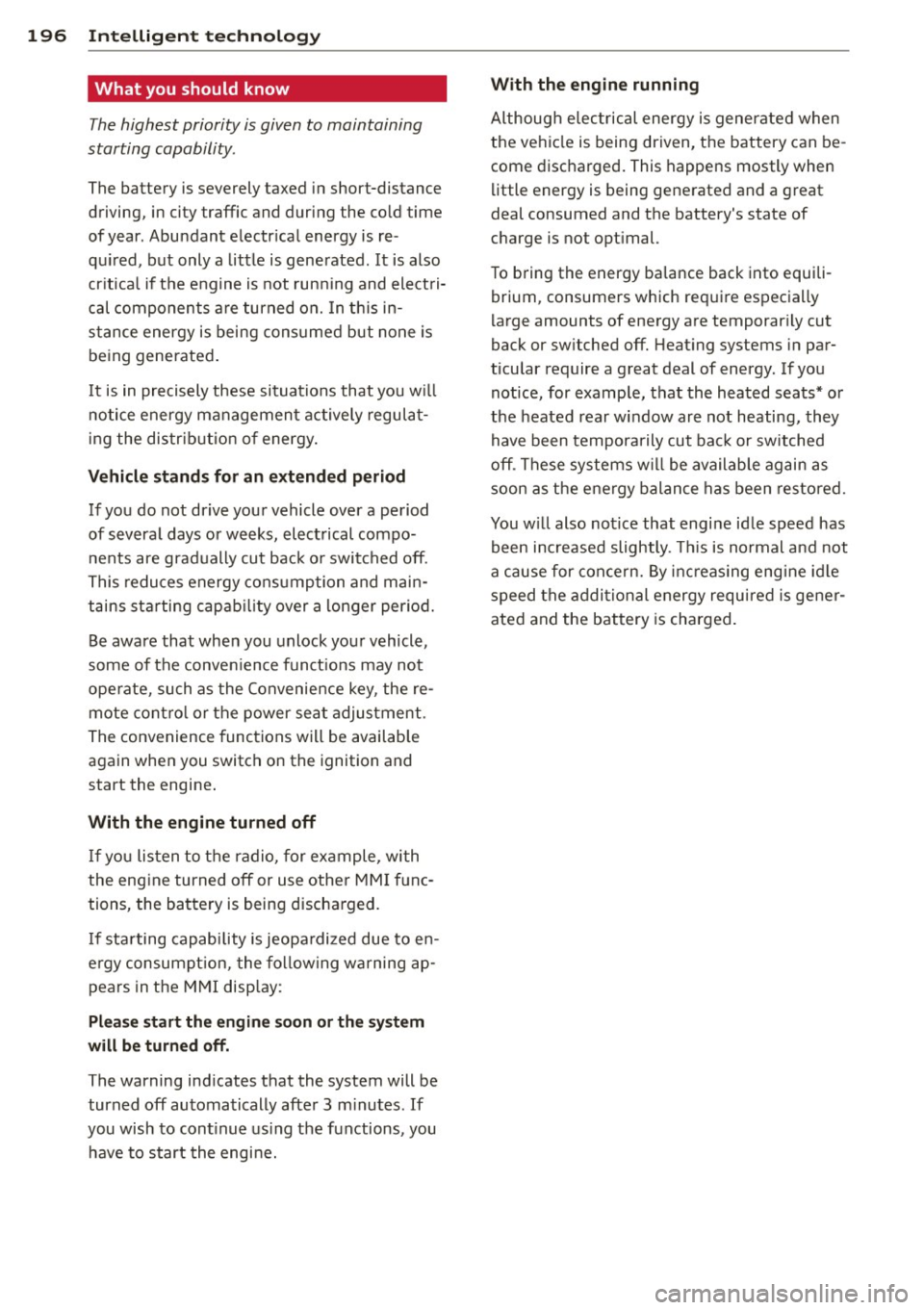
196 Intelligent technology
What you should know
The highest priority is given to maintaining
starting capability.
The battery is severely taxed in short-distance
driving, in city traffic and during the cold time
of year. Abundant electr ical energy is re
qu ired, but only a little is generated. It is also
cr itical if the e ngine is not run ning and elect ri
cal components a re turned on. In th is in
stance energy is being consumed but none is be ing generated .
I t is in precisely these situations that you w ill
notice energy managemen t actively regulat
ing the distrib ution of energy.
Vehicle stands for an ext ended period
If you do not drive your vehicle over a period
of severa l days or weeks, elect rical compo
nents are grad ually cu t back o r switched off .
This reduces energy co nsu mption and main
tains starting cap abili ty
over a longer period.
Be aware that when you unlock you r vehicle,
some of the conve nience funct ions may not
ope rate, such as the Convenience key , the re
mote cont ro l or the power seat adjustment .
The convenience functions will be availab le
aga in when you switch on the ignition and
start the engine .
With the engine turned off
If yo u lis ten to the radio, for example, with
the eng ine turned off or use othe r MM I fu nc
tions, the battery is being discharged .
I f sta rting capability is jeopa rdized due to e n
e rgy consumpt ion, the fo llow ing warning ap
pears in the MMI disp lay :
Please start th e engine soon or th e syst em
will be turned off .
The warning ind icates that the system will be
turned off automatically after 3 m inu tes .
If
you wish to cont inu e us ing the functions , you
have to start the engine.
With the engine running
Although e lec trical energy is generated when
the vehicle is being driven, the battery can be
come discharged. This happens mostly when
li ttle energy is being generated and a g reat
deal consumed and the battery's state of
charge is not optimal.
To b ring the energy ba lance back into equili
brium, consumers which req uire especially
l arge amounts of energy are temporar ily cut
back or sw itched off. Heat ing systems i n par
ticular require a great deal of energy. If you
notice , for example, that the heated seats* o r
the heated rear window are not heating, they have been temporarily cut back or sw itched
off . These systems w ill be available again as
soon as the ene rgy balance has been restored.
You w ill also notice that engi ne idle speed has
been increased slightly . Thi s is normal and not
a cause for con ce rn. By inc reas ing eng ine id le
speed the addi tional energy requ ired is gener
ated and the battery is charged.
Page 199 of 302
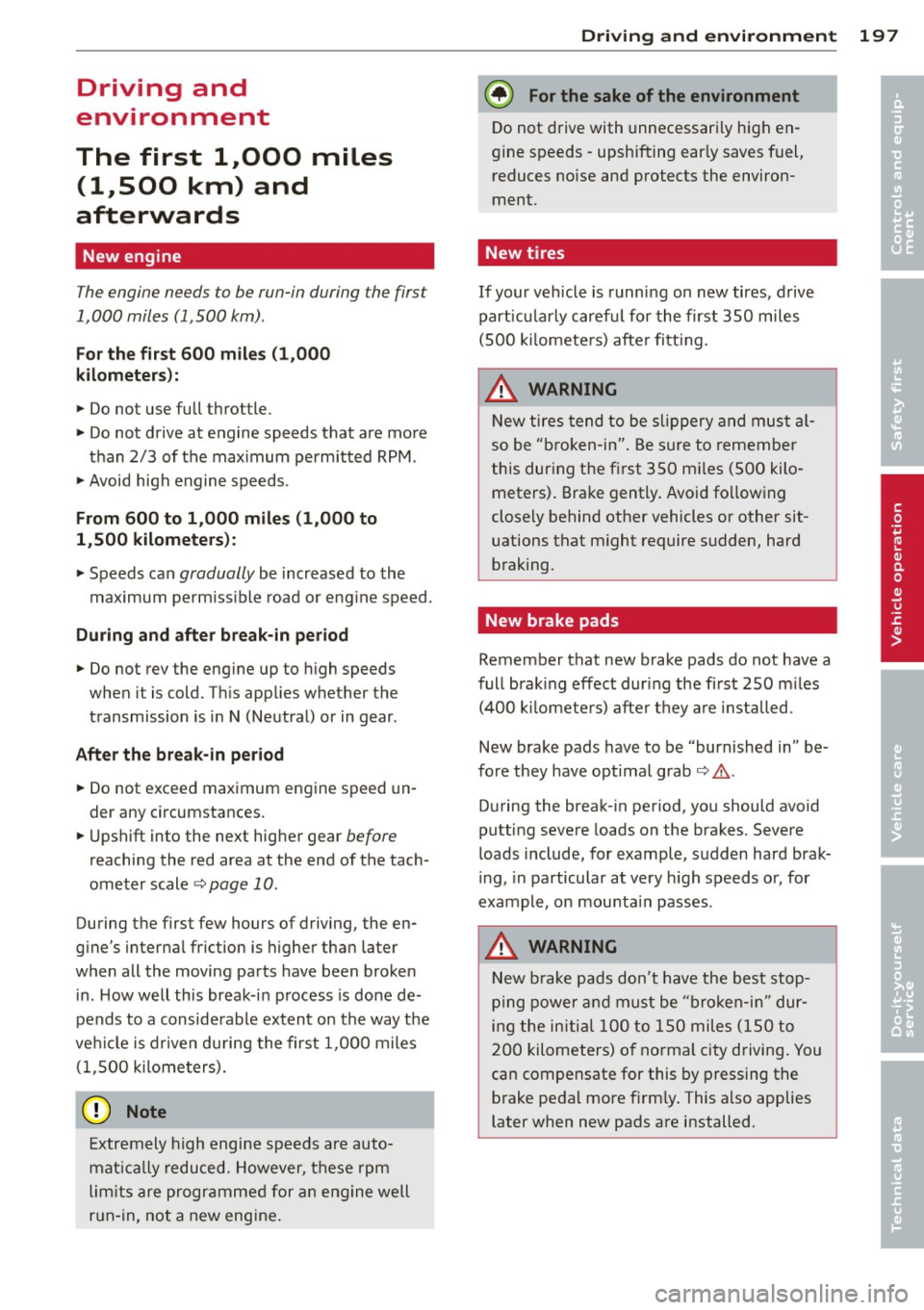
Driving and
environment
The first 1
1000
miles
(11500 km) and
afterwards
New engine
The engine needs to be run-in during the first
1,000 miles (1 ,500 km) .
For the fir st 600 mile s (1,000
kilometers ):
.,. Do not use full throttle.
.,. Do not drive at engine speeds that are more
than 2/3 of the max imum permitted RPM .
.. Avoid high engine speeds .
From 600 to 1,000 miles (1 ,000 to
1,500 kilometers):
.. Speeds can gradually be increased to the
maximum pe rm iss ib le road or eng ine speed .
During and after break-in per iod
.,. Do not rev the engine up to high speeds
when it is cold. This applies whether the
transmission is i n N (Neutra l) or in gear.
After the break- in peri od
.. Do not exceed maximum engine speed un
der any circumstances.
.,. Upshift into the next higher gear before
reaching the red area at the end of the tach
ometer scale c:.>page 10.
During the first few hours of driving, the en
g ine's interna l friction is higher than later
when all the moving parts have been broken
i n. How well this break-in p rocess is done de
pends to a considerable extent on the way the
ve hicl e is driven du ring the first 1,000 miles
(1,500 ki lome ters).
(D Note
Extremely h igh engine speeds are auto
mat ica lly reduced. However, t hese rpm
lim its are progr amme d for an eng ine well
r u n- in, not a new engine .
Driving and environment 197
@) For the sake of the environment
Do not drive with unnecessarily high en
g ine speeds -upshifting ear ly saves f uel,
reduces noise and protects the environ
ment.
New tires
If your vehicle is running on new tires, drive
particularly caref ul for the first 350 miles
(500 kilomete rs) afte r fitt ing.
.&, WARNING
N ew tires tend to be sl ippery and mus t al
so be "b roken -in" . Be sure to remember
this dur ing the f irst 350 m iles (500 kilo
meters) . Brake gently . Avoid fo llowing
closely behind other vehicles or other sit
uations that m ight require sudden, hard
b raking .
New brake pads
Remember that new brake pads do not have a
full brak ing effect dur ing the first 250 m iles
(400 ki lomete rs) afte r they a re installed.
New brake pads have to be "burnished in" be
fore they have optima l grab¢ .&, .
D uring the brea k-in period, yo u should avo id
putting severe loads on the brakes. Severe
l oads include , for example, sudden hard brak
i ng, in particular at very h igh speeds or, for
example, on mounta in passes .
.&, WARNING
New b rake pads don't have the best stop
p ing power and mu st be "broke n-i n" dur
ing the initi al 100 to 150 miles (150 to
2 00 kilometers) o f no rma l ci ty driving . You
can compensate for this by pressing the b rake peda l more fi rm ly . This also applies
later when new pads are installed.
•
•
Page 200 of 302
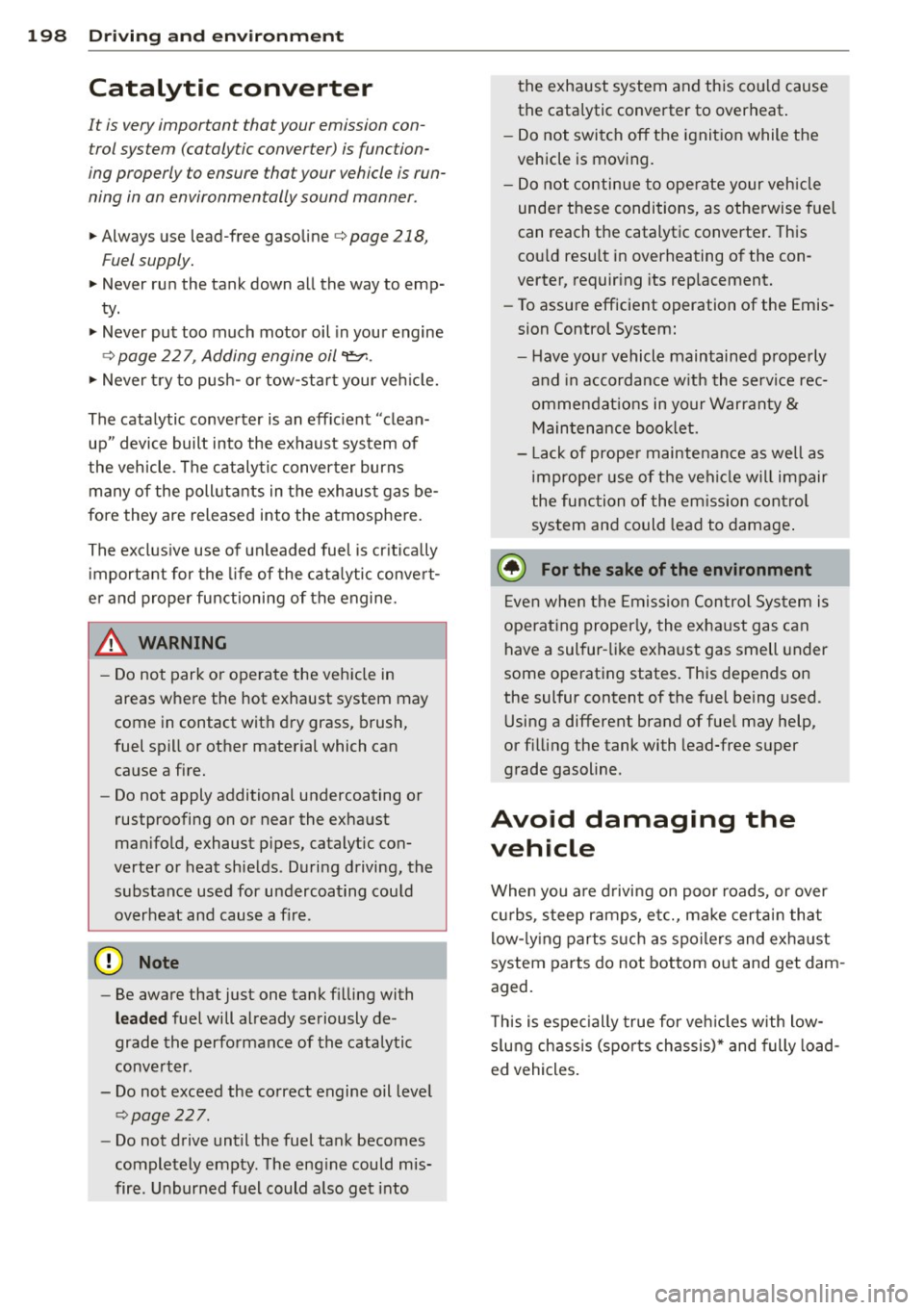
198 Driving and en vi ro nment
Catalytic converter
It is very important that your emission con
trol system (catalytic converter) is function
ing properly to ensure that your vehicle is run
ning in an environmentally sound manner .
.. Always use lead-free gasoline¢ page 218,
Fuel supply.
.. Never run the tank down all the way to emp-
ty .
.. Never put too much motor oil in your engine
¢ page 22 7, Adding engine oil 't=r. .
• Never try to push- or tow-star t your veh icle.
The catalytic converter is an eff ic ient "clean
up" device built into the exhaust system of
the vehicle. The catalytic converter burns many of the pollutants in the exhaust gas be
fore they are released into the atmosphere.
The exclusive use of unleaded fuel is critically
important for the l ife of the cata lytic conve rt
e r and proper functioning of the engine.
& WARNING
-
- Do not park o r operate the vehicle in
areas where the hot exhaust system may
come in contact with dry grass, brush,
fuel spill or other material which can cause a fire.
- Do not apply additional undercoating or
rustproofing on or near the exhaust
man ifold, exhaust p ipes, catalytic con
verter or heat shie lds . During driving, the
substance used for undercoating could
overheat and caus e a fire .
@ Note
-Be aware that just one tank filling with
leaded fuel will already seriously de
grade the perfo rmance of the catalytic
conve rter .
- Do not exceed the correct engine oil leve l
¢page 227.
-Do not drive until the fuel tank becomes
completely empty. The eng ine could mis
fire . Un burned f uel could a lso get into the exhaust system and th
is co uld cause
the cata lytic converter to overheat .
- Do not switch
off the ignition while the
vehicle is moving .
- Do not continue to ope rate your veh icle
under these conditions, as otherwise fuel
can reach the catalytic converter. This
cou ld result in overheating of the con
verter, requir ing its replacement .
- To assure efficient operation of the Emis
sion Control System:
- H ave you r vehicle maintained properly
and in accordance w it h the service rec
ommendat ions in your Warranty &
M ain tenance boo klet.
- L ack of prope r maintenance as we ll as
improper use of the vehi cle will impair
the function of the em ission contro l
system and could lead to damage .
@ For the sake of the environment
Even when the Emiss ion Control Sys tem is
operat ing proper ly, the exha ust gas can
have a sul fur -li ke ex haust gas smell under
some operating states . This depends on
the sulfur content of the fuel being used .
Using a different brand of fue l may help,
or f il li ng the tank with lead-free super
grade gasoline .
Avoid damaging the
vehicle
When you are d rivi ng on poor roads, or over
c u rbs, steep ramps, etc., ma ke certai n that
low- ly ing parts s uch as spoilers and exha ust
system parts do not bottom o ut and get dam
aged.
T his is es peci ally true for ve hicles with low
s lung chassis (spor ts chassis)* and fully load
ed vehicles .